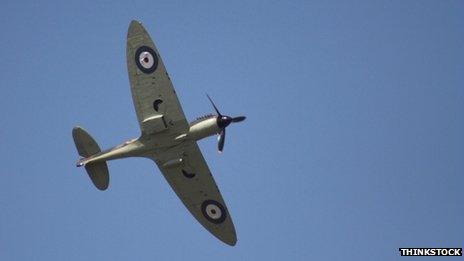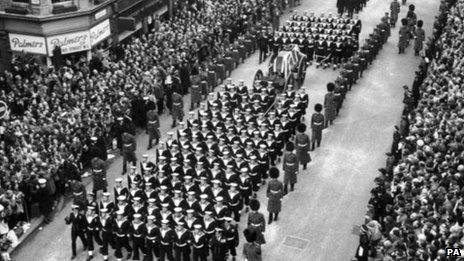Ronald Berry: Hull's Spitfire pilot from Churchill's 'Few'
- Published

Ronald Berry flew over 400 combat missions during WWII
There are plans to commemorate the life of a World War II Spitfire pilot from East Yorkshire whose exploits made him stand out, even among Winston Churchill's famous "Few".
Ronald Berry, from Hull, was so highly regarded that when the wartime prime minister died in 1965, the fighter ace was one of 14 members of the "Few" chosen to march at the head of Churchill's state funeral procession.
He was a Spitfire pilot with the Royal Air Force during what came to be known as the Battle of Britain and flew more than 400 combat missions in World War II.
During the battle, Mr Berry's exploits included shooting down three German Messerschmitt 109s in one day's fighting and he was awarded the Distinguished Flying Cross and Bar.
Winston Churchill coined the famous phrase of the "Few", referring to RAF pilots, during a speech in the House of Commons after the Battle of Britain in 1940, when he said "never in the field of human conflict was so much owed by so many to so few".

Ronald Berry was one of the "Few" chosen to play a part in the funeral procession
Hull City Council is considering creating a permanent memorial to Mr Berry, possibly with a blue plaque at the place of his birth in Westcott Street.
Mr Berry was born in Hull in 1917 and was only 23 years old when he found himself in the thick of the Battle of Britain flying with 603 Squadron.
He had learned to fly as part of the RAF Volunteer Reserve before the war, said local author Donald Chester, who has written a book about the fighter ace's exploits.
Fighting skills
The pilot's home town was heavily bombed by the German air force during the war and the author said Mr Berry "was the perfect expression of Hull fighting back".
He said during the Battle of Britain, Mr Berry shot down 10 enemy aircraft, claimed his part in the destruction of another six, had eight "probables" and also caused damage to nine.
Mr Chester said he had not initially heard about the local fighter ace but once he discovered him, he was determined to write the full story.
"I went to get press cuttings and found one from 1941. There was not even a local obituary as far as I could find," he added.
Mr Berry's nephew, Peter Long, 77, remembers as a young child seeing the pilot at the family home in Hull during World War II.
"I used to visit my grandma's even with the Blitz on. We were out in the shelter most nights," he said.
During those visits home his uncle "never used to brag about anything".
"He talked a bit about flying but it was the technical side," said Mr Long.
Mr Berry's physique helped his combat exploits because he was able to throw his Spitfire around the sky in numerous deadly dogfights, he said.
Nuclear deterrent
"Ron was small and thickset and he said it helped tremendously with the effects of G-force, he could take up more G-force," he said.
"It really did help in the twisting, tight turns of a dogfight. That's why he was never shot down," he added.
Mr Berry was promoted to the rank of squadron leader and by 1942 during Operation Torch, the Allied invasion of French North Africa, he was put in charge of a wing of five Spitfire squadrons at the age of 26.
Later he was sent to train new fighter pilots and was a wing commander by the time the war ended in 1945. He was then posted to America on an exchange with the US Air Force.
He also joined Bomber Command to lead a nuclear deterrent squadron of Valiants in the 1950s and by 1959 was working at the Air Ministry and rose to the rank of Air Commodore before retiring in 1969.
Mr Berry was appointed OBE in 1946 and CBE in 1965, and died in 2000.
- Published15 November 2012
- Published5 September 2012